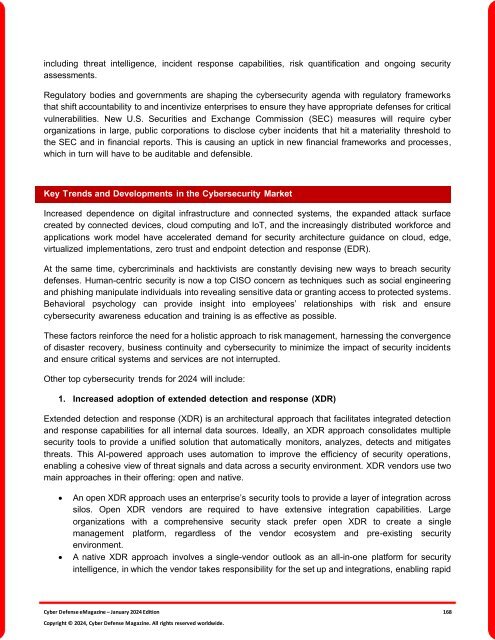The Cyber Defense eMagazine January Edition for 2024
Cyber Defense eMagazine January Edition for 2024 #CDM #CYBERDEFENSEMAG @CyberDefenseMag by @Miliefsky a world-renowned cyber security expert and the Publisher of Cyber Defense Magazine as part of the Cyber Defense Media Group as well as Yan Ross, Editor-in-Chief and many more writers, partners and supporters who make this an awesome publication! 201 page January Edition fully packed with some of our best content. Thank you all and to our readers! OSINT ROCKS! #CDM #CDMG #OSINT #CYBERSECURITY #INFOSEC #BEST #PRACTICES #TIPS #TECHNIQUES
Cyber Defense eMagazine January Edition for 2024 #CDM #CYBERDEFENSEMAG @CyberDefenseMag by @Miliefsky a world-renowned cyber security expert and the Publisher of Cyber Defense Magazine as part of the Cyber Defense Media Group as well as Yan Ross, Editor-in-Chief and many more writers, partners and supporters who make this an awesome publication! 201 page January Edition fully packed with some of our best content. Thank you all and to our readers! OSINT ROCKS! #CDM #CDMG #OSINT #CYBERSECURITY #INFOSEC #BEST #PRACTICES #TIPS #TECHNIQUES
You also want an ePaper? Increase the reach of your titles
YUMPU automatically turns print PDFs into web optimized ePapers that Google loves.
including threat intelligence, incident response capabilities, risk quantification and ongoing security<br />
assessments.<br />
Regulatory bodies and governments are shaping the cybersecurity agenda with regulatory frameworks<br />
that shift accountability to and incentivize enterprises to ensure they have appropriate defenses <strong>for</strong> critical<br />
vulnerabilities. New U.S. Securities and Exchange Commission (SEC) measures will require cyber<br />
organizations in large, public corporations to disclose cyber incidents that hit a materiality threshold to<br />
the SEC and in financial reports. This is causing an uptick in new financial frameworks and processes,<br />
which in turn will have to be auditable and defensible.<br />
Key Trends and Developments in the <strong>Cyber</strong>security Market<br />
Increased dependence on digital infrastructure and connected systems, the expanded attack surface<br />
created by connected devices, cloud computing and IoT, and the increasingly distributed work<strong>for</strong>ce and<br />
applications work model have accelerated demand <strong>for</strong> security architecture guidance on cloud, edge,<br />
virtualized implementations, zero trust and endpoint detection and response (EDR).<br />
At the same time, cybercriminals and hacktivists are constantly devising new ways to breach security<br />
defenses. Human-centric security is now a top CISO concern as techniques such as social engineering<br />
and phishing manipulate individuals into revealing sensitive data or granting access to protected systems.<br />
Behavioral psychology can provide insight into employees’ relationships with risk and ensure<br />
cybersecurity awareness education and training is as effective as possible.<br />
<strong>The</strong>se factors rein<strong>for</strong>ce the need <strong>for</strong> a holistic approach to risk management, harnessing the convergence<br />
of disaster recovery, business continuity and cybersecurity to minimize the impact of security incidents<br />
and ensure critical systems and services are not interrupted.<br />
Other top cybersecurity trends <strong>for</strong> <strong>2024</strong> will include:<br />
1. Increased adoption of extended detection and response (XDR)<br />
Extended detection and response (XDR) is an architectural approach that facilitates integrated detection<br />
and response capabilities <strong>for</strong> all internal data sources. Ideally, an XDR approach consolidates multiple<br />
security tools to provide a unified solution that automatically monitors, analyzes, detects and mitigates<br />
threats. This AI-powered approach uses automation to improve the efficiency of security operations,<br />
enabling a cohesive view of threat signals and data across a security environment. XDR vendors use two<br />
main approaches in their offering: open and native.<br />
• An open XDR approach uses an enterprise’s security tools to provide a layer of integration across<br />
silos. Open XDR vendors are required to have extensive integration capabilities. Large<br />
organizations with a comprehensive security stack prefer open XDR to create a single<br />
management plat<strong>for</strong>m, regardless of the vendor ecosystem and pre-existing security<br />
environment.<br />
• A native XDR approach involves a single-vendor outlook as an all-in-one plat<strong>for</strong>m <strong>for</strong> security<br />
intelligence, in which the vendor takes responsibility <strong>for</strong> the set up and integrations, enabling rapid<br />
<strong>Cyber</strong> <strong>Defense</strong> <strong>eMagazine</strong> – <strong>January</strong> <strong>2024</strong> <strong>Edition</strong> 168<br />
Copyright © <strong>2024</strong>, <strong>Cyber</strong> <strong>Defense</strong> Magazine. All rights reserved worldwide.

















